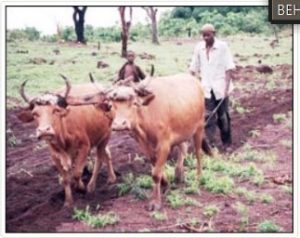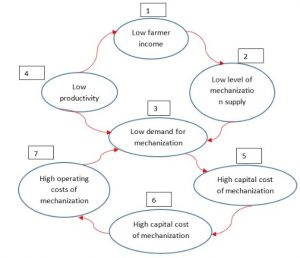Tamirat Haile
What are the Key challenges facing Agriculture in Sub-Saharan Africa?
Overview
Sub-Saharan Africa has a high potential for agriculture and large uncultivated land. Although endowed with land resources and promising potential for agriculture sub-Saharan region of the world experiences hunger and substantial undernourishment. The daily livelihood of many majorities of the population in this region depends on Agriculture. Other populations/ non-farm populations also depend on agriculture as they spent a huge portion of their income on food. Unless challenges in the agriculture sector are solved, it would be cumbersome to bring sustainable development in such regions. The bottlenecks to the problem in agriculture are multidimensional and complex which needs attention from different angles. Hence, identifying key problems and enhancing agricultural productivity plays a crucial role in alleviating poverty and stimulating economic growth in the region.
The key challenges of agriculture in sub-Saharan includes the absence of plausible farming mechanism and mechanized farm to assure food security, experiencing rainfed agriculture which produces yield only once or in rare case twice as opposed to irrigated agriculture, lack of diverse farming system, less attention on researches which address agricultural issues, post-harvest loss, poor land management, and political instability.
Rainfed Agriculture in Sub Saharan Africa
Studies indicate that irrigated agriculture is efficient in water use and economy especially for large-scale schemes and in assuring food security in food shortage regions of the world. Sub-Saharan Africa is densely populated regions with a population growth rate of 2.63% population per year. This population growth makes an imbalance between food production and demand. Although the population increase rapidly, agricultural productivity remains unimproved. A seasonal and unreliable rainfall dependent farming system is one of the basic and foremost reasons for this. Rainfed agriculture accounts for 95% of agricultural land in Sub-Saharan Africa whereas in Asia and Latin America 38 percent of the cultivated area is irrigated. In rainfed agriculture, water productivity, the amount of crop produced per drop of water low. In such an agricultural system, evaporation loss is high and due to drought, land degradation and crop death are common. Land degradation, in turn, reduces productivity, the water-holding capacity of the soil and increases soil loss through erosion leading to sedimentation in rivers and water control and diversion structures.
This all above-mentioned issues directly or indirectly exacerbates poverty in the region. For instance, if we consider a maize productivity yield of about 1.8 to 2 tons per hectare is produced in rainfed regions as compared to the world average, 5.11 tons per hectare. On the other hand, recurrent drought substantially reduces soil fertility and important nutrients. Supplementing rainfed agriculture with irrigation needs cost which may include cost for planning, design, and construction water storage and control facilities, the cost for the water distribution system, energy cost, and skilled workforce. In sub-Saharan Africa, these all amenities are lacking due to the economy of the region.
Agricultural Mechanization in Sub Saharan Africa
Another key challenge is the lack of farm power and mechanization. The necessity of mechanized farms in order to raise productivity and reduce food shortage is unquestionable in order to realize sustainable development goal number one (end poverty) and two (Zero hunger, achieving food security and improved nutrition and promoting sustainable agriculture). Lack of farm power seriously affected agricultural productivity and made stagnation in income putting the large portion of the population towards poverty and hunger. Currently, the level of mechanization in the African continent, especially in Sub Saharan, is very low as compared to other regions of the world. For instance, in Africa, there is on average about 27.5 tractors per 100 square kilometer of agricultural land, which is about 708.1 in the European Union, 271.2 in the United States and 162.5 in Canada. In sub-Saharan Africa, more than 90% of farmers practice small-scale agriculture, which is not mechanized and lacks farm power. Farming in Sub-Saharan Africa relies fully on human power with limited hand tools. Farmers use animals like oxen, donkeys, and horses for plowing (Figure 1). Mechanization increases productivity per unit area of land, helps in the expansion of the cultivation area where there is land availability, supports to accomplish difficult activities that are difficult without machinery, improves the quality of the work and makes farm work attractive. One main bottleneck to practice mechanized farms in sub-Saharan Africa is due to the economy of the farmers, lack of added value to crops that are sold, awareness and their small landholding. On average farmers hold less than 2 hectares and in the family, there may be up to five members, which makes the problem worse. Not all family members often will participate in farming especially the young generation migrate from rural to urban areas for a better life and relay on off-farm income.

Figure 1: Farmer in Guinea (source: Food and Agriculture issues in developing world http://factsanddetails.com/world/cat57/sub383/item2130.html)
There is very little surplus cash generation, which results in low potential in improving inputs like machinery, fertilizers, and seeds. This, in turn, results in low production and keep the farming system subsistence or situation of low income. Figure 2 below represents the factors that deteriorate demand and supply of agricultural mechanization.

Figure 2: Factors causing deterioration in demand and supply of agricultural mechanization
(Source: Houmy et al.2013)
Another problem for the expansion of mechanization is low skill and knowledge of farmers. Access to knowledge for farmers is very limited in sub-Saharan African countries. Farmers are stacked to traditional knowledge and opportunities for training are limited. Agricultural operations are done manually still today. Even in areas using machinery, there is misuse and skill gap in the operation of machinery. The government sometimes hires agricultural extension experts but their knowledge is not too far from that of the traditional due to the reason that training they got is also limited.
The other constraint in line with mechanized farms is less use of fertilizers compared to other regions of the world. According to the World Bank report (2007), fertilizer use in Africa is 13 kg/ ha whereas in Asia and Latin America average use of fertilizer is about 208 kg per hectare. This could be one of the causes for the reduction in crop yield in sub-Saharan Africa, which is one-third of East Asian yield. Low use of fertilizers on top of reducing productivity also causes a reduction in soil fertility and an increase in soil degradation.
Research and Development
Research and development is crucial in solving the agricultural problem and creating awareness. Little attention is given to research and development on the private sector’s side and the public sector too in Sub-Saharan Africa. The focus of the private sector is to maximize their profit by selling new and better products. The public institution on the other has no enough finance to promote research and development. Enhancing research and development capability plays a significant role in creating awareness, improving existing agricultural practices and in maximizing profit.
References
Binswanger-Mkhize, H. P. (2009, June). Challenges and opportunities for african agriculture and food security. In Proceedings of the FAO Expert Meeting on How to Feed the World in (Vol. 2050).
Bowers, D. (2007). Farm Power and Mechanization for Small Farms in Sub-Saharan Africa. By BG Sims and J. Kienzle. Rome: Food and Agriculture Organization of the United Nations (2006), pp. 65, US $26.00. ISSN 1814-1137. Experimental Agriculture, 43(3), 401-401.
Food and agriculture issues in the developing world http://factsanddetails.com/world/cat57/sub383/item2130.html
Houmy, K., Clarke, L. J., Ashburner, J. E., & Kienzle, J. (2013). Agricultural mechanization in sub-Saharan Africa: guidelines for preparing a strategy (Vol. 22). Food and Agriculture Organization of the United Nations (FAO).
Shimeles, A., Verdier-Chouchane, A., & Boly, A. (2018). Introduction: Understanding the Challenges of the Agricultural Sector in Sub-Saharan Africa. In Building a Resilient and Sustainable Agriculture in Sub-Saharan Africa (pp. 1-12). Palgrave Macmillan, Cham.
Media Attributions
- Farmers in Guinea
- Factors causing deterioration in demand and supply of agricultural mechanization